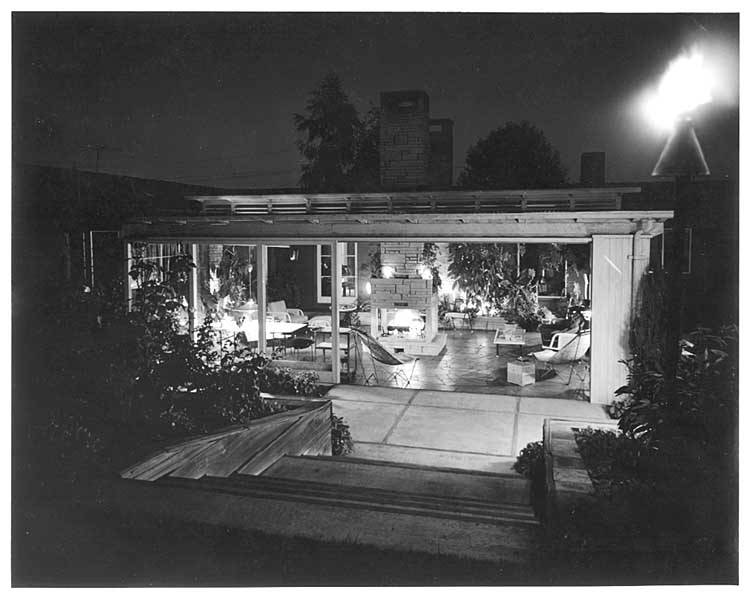 Kuhns house exterior at night
Kuhns house exterior at nightUniversity of Washington Libraries, Special Collections, Hupy 5181-6
Photographs by Art Hupy (1924 — 2003) of beautiful mid-century homes in and around Seattle (many if not all designed by architects trained at the University of Washington), from the UW Libraries' Special Collections digital image archive. It's well worth a visit; much more here.
 Gene Zema house showing living room, Seattle, ca. 1966.
Gene Zema house showing living room, Seattle, ca. 1966.University of Washington Libraries, Special Collections, Hupy 4226-28
 Lovett House exterior, Hilltop neighborhood,* Bellevue, WA.
Lovett House exterior, Hilltop neighborhood,* Bellevue, WA.University of Washington Libraries, Special Collections, Hupy 5157-4
 Hodge House interior showing living room.
Hodge House interior showing living room.University of Washington Libraries, Special Collections, Hupy 5180-5
 Hodge house interior showing living room.
Hodge house interior showing living room.University of Washington Libraries, Special Collections, Hupy 5180-1
 Morse House at night, Hilltop neighborhood, Bellevue, WA (built 1948).
Morse House at night, Hilltop neighborhood, Bellevue, WA (built 1948).University of Washington Libraries, Special Collections, Hupy 5155-9
 Morse house interior showing living and dining room.
Morse house interior showing living and dining room.University of Washington Libraries, Special Collections, Hupy 5155-6
 Perry Johansen house courtyard, ca. 1955
Perry Johansen house courtyard, ca. 1955University of Washington Libraries, Special Collections, Hupy 4222-18
 Prechek house, exterior, Hilltop neighborhood, Bellevue, WA (built 1952).
Prechek house, exterior, Hilltop neighborhood, Bellevue, WA (built 1952).University of Washington Libraries, Special Collections, Hupy 5153-2
 Prechek house, living room.
Prechek house, living room.University of Washington Libraries, Special Collections, Hupy 5153-5
 Smith house exterior, Hilltop neighborhood, Bellevue, WA (built 1949).
Smith house exterior, Hilltop neighborhood, Bellevue, WA (built 1949).University of Washington Libraries, Special Collections, Hupy 5152-6
 Smith house interior.
Smith house interior.University of Washington Libraries, Special Collections, Hupy 5152-2
 Thomas Graham house interior showing living room, Seattle, 1956.
Thomas Graham house interior showing living room, Seattle, 1956.University of Washington Libraries, Special Collections, Hupy 6169-1
 Webster house, living room, Port Angeles, WA (Paul Kirk, architect).
Webster house, living room, Port Angeles, WA (Paul Kirk, architect).University of Washington Libraries, Special Collections, Hupy 5120-14
*According to UW Libraries:
Hilltop is the second-oldest cooperative residential development in King County. It was established in 1947, founded by individuals who, after bypassing conventional real estate developers, planned a community that was founded on the desire to utilize principles of modern planning and architectural design to enhance the natural beauty of each home site and to make possible a sharing of benefits and opportunities among the members on as equal and democratic a basis as possible. Founding members intended that site plans and buildings should have a straightforward contemporary character and that there should be no racial restrictions and no requirements as to the size or cost of homes. [Source: A half-century on the hill: collected memories from 50 years of community living. Edited by Connie Reed, et al. Hilltop, Wash.: Hilltop Community, 1998?].Charles Anderson, a Seattle-based architect who resides in Hilltop, provides an interesting summary of the community's beginnings here. An excerpt:
Having lived in a ‘contemporary’ [John] Morse designed house for more than 40 years, [resident Victor] Scheffer had this to say: “If I may speak for the founders, I suggest that ‘contemporary’ is functional, designed more for comfort, utility, and internal beauty than for display. As though to acknowledge humankind’s primal link to the planet, it favors the use of natural materials such as wood and stone, complemented by the lightness of space... It stands for honest construction... It expresses the richness of simplicity." . . . [E]ach site was established not as a piece of property, but as a specific place in the landscape. Each place had a floor elevation that had a precise relationship to the site. The first community plan drawing depicted each site as a rectangular platform with a number in feet above sea level. The physical manifestation of the Hilltop dwellings began as conceptual camping platforms where the early community members hiked and explored. This initial idea carried through to the design of many of the actual houses. Some are concrete slab-on-grade (left exposed) while others hover as slightly elevated wooden platforms.